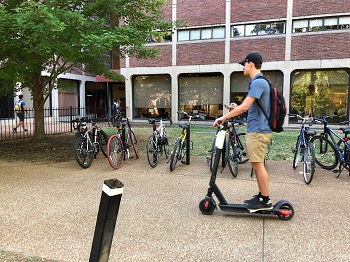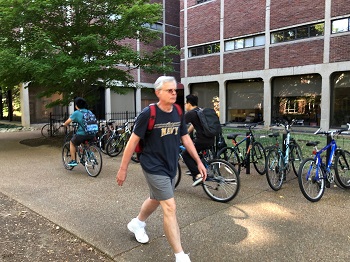Transportation engineers put sophisticated eyes on campus mobility and air quality

Do riders of bicycles and scooters dismount before crossing the pedestrian bridge over Hillsboro Road, as they should? How does the air quality at 21st and Broadway compare to campus areas with more tree cover? What are the pedestrian, bicycle, scooter and automobile traffic patterns at 21st and West End Avenue?
The data is coming.
The first of what could be two dozen sophisticated sensor arrays—called the MoveVU Digital Gateway—has started collecting air quality and mobility data on the campus from the corner of 21st Avenue South and Edgehill Avenue. The sensor, equipped with a camera, is part of large-scale, $9 million project backed by federal, state and university funding.
“We wanted to choose intersections that are major entry points to campus, and that have points of interest,” said Caroline Janssen, a senior civil engineering major on the project team. “The pedestrian bridge is an obvious hot spot.”
Two other sensors are expected to be online by the end of October. One will be near the Baker Building at West End and 21st and 21st and Broadway. The former is along a five-mile “walk and roll” loop under construction to distribute foot, pedal and scooter traffic while creating a more park-like vibe on campus. The latter will capture data at the site of a new graduate and professional student housing village, on which work also has begun. Another sensor array is installed atop Medical Research Building III and at a temporary spot on the roof of the Music Row building that is home to the Vanderbilt Institute for Software Integrated Systems.

Initial sensor placement gives engineers and campus planners a fully monitored corridor for analysis of traffic ebb and flow, Janssen said.
She worked over the summer with Erin Hafkenschiel, Vanderbilt’s Executive Director of Mobility, on Vanderbilt’s MoveVU plan to expand mobility. She also has worked in the lab of Dan Work, associate professor of civil and environmental engineering and computer science, for more than a year.
The ambitious project will make Vanderbilt “a preeminent university test bed for managing mobility and improving air quality,” Work said.

The arrays measure levels of carbon monoxide, ozone, air particulates, weather conditions, noise levels and more, including three types of light produced by the sun. In concert with other Internet-linked devices, such as shared scooters and bicycles, automobile GPS systems and mobile phones, the system capture mobility patterns in ways that anonymize the data and protect individual privacy.
The sensors leverage three technologies:
● Array of Things, which are customizable sensor nodes and, in this case, based on more than 100 used and tested in Chicago;
● Multisensor camera, which collects video data to run computer vision techniques and determine traffic modes and trajectories
● BlueTOAD, a proprietary technology by TrafficCast, which uses Bluetooth signatures to identify and anonymously track passing vehicles to later reconstruct travel times and likely routes from specific data points.
Metro Nashville and the Tennessee Department of Transportation also have – or will have – BlueTOAD sensors and the partnership with Vanderbilt gives the project regional scope.
But collecting data is only the beginning. Researchers will process it with computer vision and machine learning algorithms to support development of tools to improve everything from traffic signal timing to congestion management to environmental protection and transit planning. The engineering components of the sensor project also include Ph.D. students Yanbing Wang and Will Barbour (civil and environmental engineering) and Yue Hu (electrical engineering and computer science).
Other targets for optimization include travel mode choice, routing, sidewalk usage and safety.
“The convergence of technology and transportation provides new opportunities to design transportation services that are smart, sustainable, resilient, and efficient,” Work said.
Vanderbilt in late 2018 received a $4.5 million, three-year grant through the federal Congestion Mitigation and Air Quality Improvement program to encourage greater use of sustainable travel options among faculty, staff and students. With the university’s $4.5 million match, the program will fund shuttle operations, shuttle shelters, bike share shelters and other efforts in addition to sensor rollout.
Contact:
Pamela Coyle (615) 343-5495
Pam.Coyle@Vanderbilt.edu
Twitter @VUEngineering
